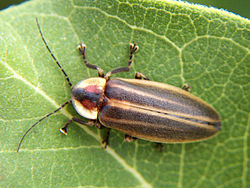| Photurinae | |
|---|---|
 | |
| Adult Photuris lucicrescens | |
| Scientific classification | |
| Kingdom: | Animalia |
| Phylum: | Arthropoda |
| Class: | Insecta |
| Order: | Coleoptera |
| Suborder: | Polyphaga |
| Infraorder: | Elateriformia |
| Family: | Lampyridae |
| Subfamily: | Photurinae |
| Genera | |
see text [1] | |
The Photurinae are a subfamily of fireflies (Lampyridae). They contain many of the well-known North American species, such as the Pennsylvania firefly (Photuris pennsylvanica), state insect of Pennsylvania. They are among the "flashing" (as opposed to continuous-glow) fireflies known as "lightning bugs" in North America, although they are not too distantly related to the flashing fireflies in the Lampyrinae; as the most basal lineages of that subfamily do not produce light at all, the Photurinae's flashing signals seem to be convergent evolution. [2]
Contents
The genus Photuris is often called " femme fatale fireflies", due to the females' habit of imitating other "lightning bugs'" flashes, to attract, kill, and eat them. Their prey includes such unrelated Lampyrinae like rover fireflies (Photinus) or Pyractomena . [2]